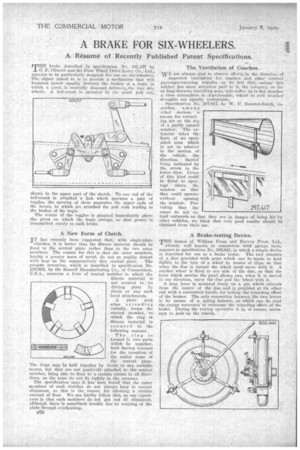A BRAKE FOR SIX-WHEELERS.
Page 36

If you've noticed an error in this article please click here to report it so we can fix it.
A Resume of Recently Published Patent Specifications.
THE brake described in specification. No. 301,157 by
C. F. Cleaver and the Four Wheel Drive Lorry CO., Ltd., appears to be particularly designed for use on six-wheelers. The object aimed at is to provide a. mechanism that will 'transmit power equally between the brakes of a bogie in -which a rivet is centrally disposed. betweenrthe two side wheels. A bell-erank is operated by the usual pull rod;
shown in the upper part of the sketch. To oue zlid of the bell-crank is attached a link which operates a pair of toggles, the opening of these separates the upper ends of the levers, to which are attached the pull rods leading to the brakes of the bogie.
The centre of the toggles is situated immediately above the pivot on which the bogie swings, so that power, is transmitted evenly to each brake.
A New Form of Clutch.
IT has recently been euggested that, with single-plate clutches, it is better that the fibrous material should be fixed to the central plate rather than to the two outer members. The reason for this is that the outer members, having a greater mass of metal, do not so readily distort with heat as the comparatively thin central plate. The present invention, which is described in specification No. 280392, by the Russell Manufacturing Co., of Connecticut. U.S.A.., concerns a form of central mernber in which the fibrous material is net secured to its driving plate by rivets or any suet 'local attachments.
A plate with arms extending radially, forms the central member, to which the ring of fibrous material is secured in the following manner.
The ring is formed in two parts which lie together, both having recesses for the reception of the radial arms of the central plate. The rings may be held together by rivets Or any suitable means, but they are not positively' attached to the central member, being able to float to a certain extent in all directions, as the arms do net fit tightly in the recesses.
The specification says it has been found that the outer members of such clutches do not always keep in correct alignment, so this is the reason for allowing a certain amount of float. We can hardly follow this, as our experience is that, such members do not get out of alignment, although there is sometimek trouble due to warping of the plate through overheating.
The Ventilation. of Coaches.
wE are always glad to observe efforts in the direction of improved ventilation for coaehes and other covered passenger7carrying vehicles, as we ,feel that, unless this
subject has more attention paid to it, the industry, so far as long-distanee teaVelling goes,-wili suffer, as in hot weather close atmosphere is objectionable, whilst in cold weather
30115/ draughts are equally undesirable.
of a partly opened window. The ex tractor takes the form of an opensidedcone which is set in relation to the motion of the • vehicle, the direction thereof being indicated by the arrow in the lower view. Cones of this kind could be fitted to open ings above the
-window so that they could operate
without opening the window. Providing that the cones do not extend outwards so that they are in other vehicles, we think that very obtained from their use.
A Brake-testing Device.
THE names of William Frost and Harvey Frost, Ltd.,
already well known in connection with garage, tools, appears in specification No. 300,943, in which a simple device is described for use as a. brake tester. The tool consists of a disc provided with arms which can be --made to hold tightly to the tyre of a wheel by means of clips, go that when the disc is turned the wheel must move with it. A ratchet wheel is fixed to one side of the disc, . so that the lever which carries the Pawi shown can, when it is moved in one direction, carry the disc and the wheel with it.
A long lever is mounted freely on a pin which extends from the centre of the disc and is provided at its other end with a convenient handle for testing the retarding effect of the brakes. The only connection between the two levers is by means of a spring balance, on which can be read the energy necessary to overcome the retarding effect of the brake. During the testing operation it is, of course, necessary to jack up the wheels.




































